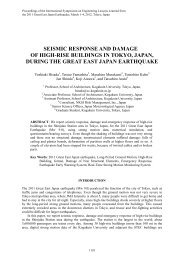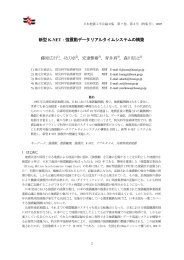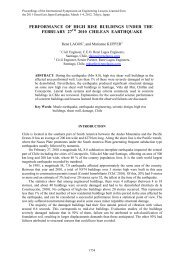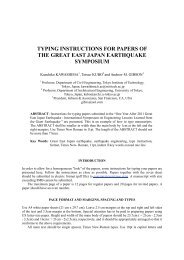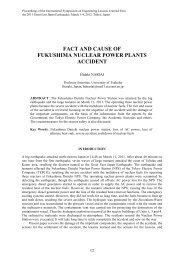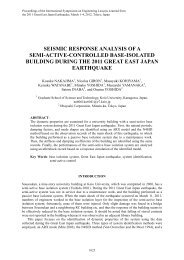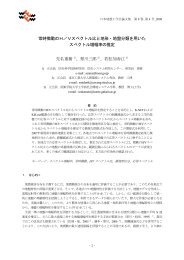Application of Seamless Simulation of Seismic Response Analysis ...
Application of Seamless Simulation of Seismic Response Analysis ...
Application of Seamless Simulation of Seismic Response Analysis ...
- No tags were found...
Create successful ePaper yourself
Turn your PDF publications into a flip-book with our unique Google optimized e-Paper software.
38°30’NatoriSendaiArahama38°15’38°00’140°45’ 141°00’ 141°15’Fig. 2 Target area. Arahama, Wakabayashi ward, Sendai city, Japan.The inputs <strong>of</strong> SRA are the shape <strong>of</strong> structures and input SGM. We convert structure shape data inCCM to inputs <strong>of</strong> SRA; see arrow (iii) in Fig.1. Since properties <strong>of</strong> structural members are notavailable in GIS, we guess the material properties and configuration <strong>of</strong> structural members using theexternal shape <strong>of</strong> structures based on the design code <strong>of</strong> Japan. SRA is performed using apre-developed code using One Component Model (OCM). OCM is a non-linear structural analysismethod designed for analysis <strong>of</strong> RC structures. The output <strong>of</strong> SRA is the time series <strong>of</strong> displacement <strong>of</strong>structures. We assume a criterion for a structure to collapse and change the CCM according to SRAresults; see arrow (iv) in Fig.1. For simplicity, we assume that a structure will collapse if the maximumdrift angleR = max|u|/h, (1)is larger than a threshold R 0 . Here, max|u| is the maximum displacement during the simulation and h isthe height <strong>of</strong> a structure. We modify the shape <strong>of</strong> a structure by making the height 1/4 and spreadingthe structure 1.5 times in the horizontal directions if a structure is determined to be collapsed.The inputs <strong>of</strong> HRTS are the external shapes <strong>of</strong> structures and ground elevation, and input tsunamiwave. We convert the structure and ground elevation data in CCM for HRTS; see arrow (v) in Fig.1.We use a distributed memory type parallel analysis program using Smoothed Particle Hydrodynamics(SPH) for fluid analysis; see (Monaghan 1994) for details <strong>of</strong> SPH. The output <strong>of</strong> HRTS is a time series<strong>of</strong> fluid position, velocity and pressure. We do not change the configuration <strong>of</strong> the city based on HRTS,although we plan to do this in the future using a fluid-structure interaction method.APPLICATION TO COASTAL AREA OF SENDAI CITYWe apply the developed method to Arahama, Wakabayashi ward, Sendai, Japan, which is one <strong>of</strong> theseverely hit areas by the tsunami in the 2011 Tohoku earthquake; see Fig. 2. The objectives <strong>of</strong> thissection is to check that a seamless simulation <strong>of</strong> SRA and HRTS can be run on GIS datasets forestimation <strong>of</strong> overall damage in coastal areas under earthquake-tsunami disasters.We first convert data stored in GIS to CCM. The target area is a 2.0 x 3.0km domain with 1416structures. CCM consists <strong>of</strong> ground elevation and external shapes <strong>of</strong> structures; see Fig. 3. Here, GISdata provided by the Geospatial Information Authority <strong>of</strong> Japan and NTT Geospace Corporation isused as an input.We make an input city model for SRA and excite structures using SGM observed at K-NETMYG013 station (Sendai) in the 2011 <strong>of</strong>f the Pacific coast <strong>of</strong> Tohoku earthquake. For simplicity, we542




